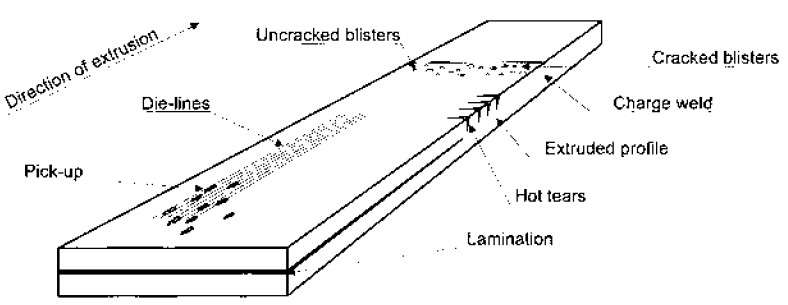Surface defects of extruded aluminium
Find out about the surface defects in extruded aluminium profiles and how to achieve superior surface quality through effective control of production technology.
Surface defects of extruded aluminium
Extruded aluminium is usually characterized by high quality of its surface. A combination of smooth and flat surface, outstanding optical properties and high corrosion resistance – all this gives aluminium profiles decisive advantages as compared with other metallic materials, for example, steels.
However, the surface quality of aluminium profiles is highly dependent on die design, quality metal of billet and extrusion technology. Therefore, with poor control of the production technology of aluminium profiles, various aluminium extrusion surface defects can occur [1-4]. Some typical surface defects of extruded aluminum profiles are shown in Figure 1:
- Pick-ups
- Die-lines
- Blisters
- Hot tears
- Charge welds.
See more about surface defects of extruded aluminium.
 Figure 1 – Typical surface defects of extruded aluminium [1]
Figure 1 – Typical surface defects of extruded aluminium [1]
Below we will consider “popular” extrusion of aluminum profiles 6xxx alloys defect, primarily, alloys 6060 и 6063 – defect “pick-ups”.
Pick-up defect
English name
The English spelling of the defect has various variations:
- pick ups,
- pick-ups
- pickups.
The combination “pick up” is used in English to mean the following actions: hook it up, pick up and so on.
German name
This defect has the following German variants of the name [2]:
- Preßsflöhe (“press fleas”) – main name;
- Preßfischchen (“press fish”);
- Preßabrieb (“press abrasions”);
- Klebstellen (Kleb – glue].
Details of the defect
The German catalog of defects for extruded aluminum profiles [2] gives the following description of the defect of Preßsflöhe (pick-ups):
- Fine particles of aluminum and aluminum oxide, which were taken from the surface of the aluminum profile and later settled again on its surface.
- Have the form of a comma or a comet, which are oriented in the pressing direction.
- May occur in conjunction with the defect “longitudinal tracks of die”.
In the dissertation [3], this defect is described as follows:
“Pick-ups defect looks like broken lines of grooves (scoring), which often [but not always] end in a lump of aluminum particles (sticky), which rises above the surface of the profile “.
The defwct appearance
A schematic view of the defect “pick-ups is shown in Figure 2.
Figure 2 – Typical schematic appearance of a pick-ups defect [2]
Figure 3 – Defect «pick-ups» on the just extruded profile
without any additional processing [2]
Sources:
1. Storen S. and Moe P.T. Extrusion // Handbook of Aluminum: Vol. 1/ George E. Totten, D. Scott MacKenzie, 2003.
2. Merkmale von Aluminium-Strangpreßprofilen Oberflächen / IWK Aachen, 2001.
3. Surface Quality of Aluminium Extrusion Products / Xiao Ma, PhD Thesis, University of Twente, Enschede, The Netherlands, 2011.



